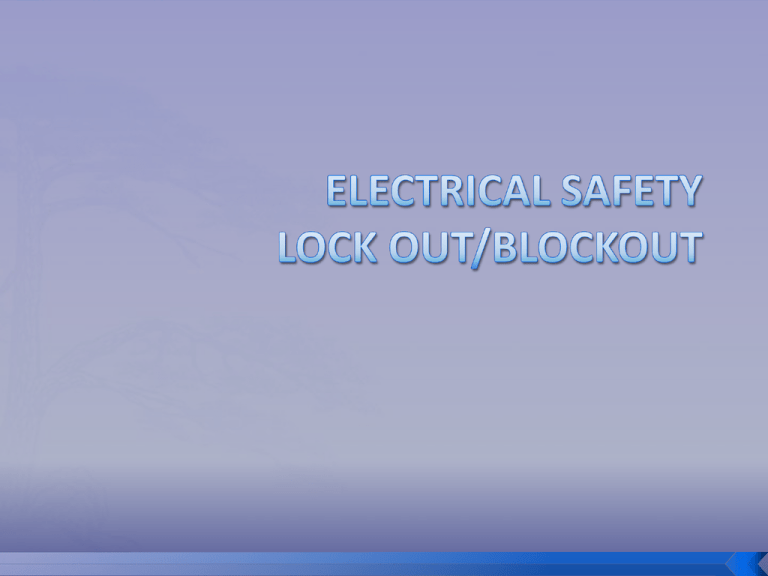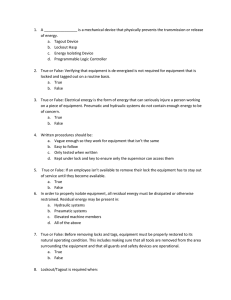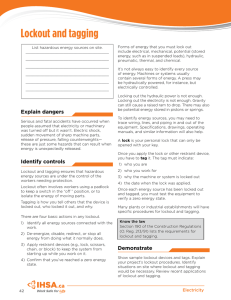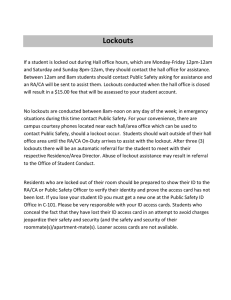Electrical Safety Training Presentation
advertisement

Read and follow all equipment operating instructions for proper use, this includes preventative and routine maintenance Leave equipment repairs and adjustments to authorized personnel, if you have not been trained to perform repairs- DON’T! Submit equipment repairs to M&O work orders for electrical repairs Never ignore electrical problems Report: Burning odors Loose connections Frayed, cracked or broken wires Choose proper cords and connectors for job, extension cord diameter should be at least as big as the electrical cord for the equipment in question Turn off equipment when finished with job Always clean up spills on floors Keep work areas clean and dry Good Housekeeping used in conjunction with well-planned layout of TEMPORARY wiring will reduce the dangers of fire and shock hazard. Employees are required to report any obvious hazard to life or property in connection with electrical equipment or lines as soon as possible? Employees are required to make preliminary inspections and/or appropriate tests to determine condition of the equipment before starting work on electrical equipment or lines When electrical equipment or lines are to be serviced, Lockout/Blockout procedures must be engaged. All portable electrical tools and equipment must be grounded or of the double insulated type All electrical appliances such as vacuum cleaners, polishers, vending machines, etc., must be grounded All extension cords must have a grounding conductor Multiple plug adaptors are prohibited Lockout/Blockout means that any energy source — whether electrical, hydraulic, mechanical, compressed air, or any other source that might cause unexpected movement—must be disengaged or blocked, and electrical sources must be de-energized and LOCKED or positively sealed in the OFF position before beginning maintenance or repairs. But even a locked-out machine may not be safe if there are parts of the machine that are not BLOCKED to prevent inadvertent movement. Potential energy that may need to be blocked can come from suspended parts, subject to gravity, or may be energy stored in springs. There is a difference between turning off a machine and actually disengaging or de-energizing a piece of equipment. When you turn off a control switch, you are opening a circuit. There is still electrical energy at the switch, and a short in the switch or someone inadvertently turning on the machine may start the machine running again. All Employees, shall adhere to the Lockout/Blockout program standard. Any employee who encounters a Lockout/Blockout tag or lock on any item of equipment is to refrain from attempting to activate or use that equipment. Call Maintenance at (916) 686-7745 if you need to use the equipment or access the area. Lockout/Blockout prevents the unexpected start-up of moving machine parts or the release of stored energy in a piece of equipment. Lockout/Blockout applies when routine service or maintenance work is performed on machinery or equipment. Other tasks which require the use of Lockout/Blockout: Installations Adjustments Repairs Inspections Modifications (Manufacturer Approved) Cleaning Lubricating Unjamming Changing Tools Must be used when: When you remove or bypass machine guards or other safety devices When you make, or are close to making, bodily contact with the machine’s point of operation When your body is in a danger zone associated with a machine operating cycle. Authorized Employee Affected Employee Workers who are required to perform Lockout/Blockout procedures Workers who work with or near equipment that will be locked and tagged out ALL Employees must understand and respect Lockout/Blockout procedures. Locks CONTROL AND ISOLATE ALL the equipment’s energy sources Used to block the flow of energy Placed on equipment by “Authorized Employee” Only the “Authorized Employee” has the key to remove such lock Tags are a warning to all employees not to turn the power on, tags alone are not sufficient for Lockout/Blockout purposes Must: Be standardized include authorized employee’s name Be legible and understandable Be durable Be securely attached Include a clear warning Must State: DO NOT OPEN DO NOT START NO NOT ENERGIZE DO NOT OPERATE Hazardous Energy Control Procedures: DE-ENERGIZE: EGUSD District Procedures 1. Preparation: Know the equipment and it’s energy source before working on it. Check with the supervisor for a written procedure or checklist that details the shutdown of the equipment you’re working on. Notify the affected staff that you will be shutting down the equipment 2. Shutdown: Turn off the equipment. Check with the supervisor if you are unsure of any part of the shutdown. 3. Isolation: Find and isolate every form of energy that the machine uses. Including pulling fuses, throwing disconnects and capping any secondary sources of energy. Do not stop with pulling a fuse, which can simply be replaced. 4. Application: Locks or tags must be applied to ALL energy-isolating equipments, valves and switches. Lockout: Anything that might restore of the flow of energy to the work area must be locked. Tagout: Include tags with locks to help other employees identify a lockout. Tags should explain the work being done, give the estimated work time and the name of the “authorized” employee who placed the lock. Place tags as close to the lock as possible. If equipment cannot be locked place tags as close as possible to the energy isolating device. Newer equipment and any that is being update must now be capable of being locked. Multi-Lock: With multiple locks in use, an authorized employee will place all keys in a lock box to which each employee attaches his or her personal lock. No one can get the keys for the locks on the equipment until all personnel have finished their part of the work and have removed their locks from the box. 5. Control: After equipment is locked out, you must control stored energy Relieve, disconnect or restrain any residual hazardous energy that could be present. Check that all moving parts have stopped Relieve trapped pressure Blank pipe flanges Install ground wires to discharge electrical capacitors Block or support elevated equipment While performing service, check continuously if energy build up is possible. 6. Verify: Make sure every energy source is shut down, blocked off, controlled and locked or tagged out. Warn everyone in the lockout area and be sure they are moved to a safe place. Activate controls that might restore power to the machine you are working on. If equipment does not start, restore all controls to the off position and begin work. RE-ENERGIZE: EGUSD District Procedures Restore Work Area: Remove all tools Double-check all equipment components Replace all safety features, such as machine guards Close all access panels that were opened to perform service on equipment. Notify Personnel: Notify all affected employees that lockout/tagout devices are being removed. Remove employees from the area or make sure they are a safe distance from the equipment. Remove Lockout/Tagout Devices: The person who placed each device must be the one to remove it. If someone who placed a lockout/tagout device is not present, notify your supervisor who will follow specific procedures. NEVER REMOVE ANOTHER EMPLOYEE’S LOCK!! Are ground-fault circuit interrupters installed on each temporary 15 or 20 ampere, 120 volt alternating current (AC) circuit at locations where construction, demolition, modifications, alterations, or excavations are being performed? Are all temporary circuits protected by suitable disconnecting switches or plug connectors at the junction with permanent wiring? Do you have electrical installations in hazardous dust or vapor areas? If so, do they meet the National Electrical Code (NEC) for hazardous locations? Are exposed wiring and cords with frayed or deteriorated insulation repaired or replaced promptly? Are flexible cords and cables free of splices or taps? Are clamps or other securing means provided on flexible cords or cables at plugs, receptacles, tools, equipment, etc., and is the cord jacket securely held in place? Are all cord, cable and raceway connections intact and secure? In wet or damp locations, are electrical tools and equipment appropriate for the use or location or otherwise protected? Is the location of electrical power lines and cables (overhead, underground, under floor, other side of walls, etc.) determined before digging, drilling, or similar work is begun? Are metal measuring tapes, ropes, hand-lines or similar devices with metallic thread woven into the fabric prohibited where they could come in contact with energized parts of equipment or circuit conductors? Is the use of metal ladders prohibited where the ladder or the person using the ladder could come in contact with energized parts of equipment, fixtures, or circuit conductors? Are all disconnecting switches and circuit breakers labeled to indicate their use or equipment served? Are disconnecting means always opened before fuses are replaced? Do all interior wiring systems include provisions for grounding metal parts of electrical raceways, equipment and enclosures? Are all electrical raceways and enclosures securely fastened in place? Are all energized parts of electrical circuits and equipment guarded against accidental contact by approved cabinets or enclosures? Is sufficient access and working space provided and maintained around all electrical equipment to permit ready and safe operations and maintenance? Are all unused openings (including conduit knockouts) in electrical enclosures and fittings closed with appropriate covers, plugs, or plates? Are electrical enclosures such as switches, receptacles, junction boxes, etc., provided with tight-fitting covers or plates? Are disconnecting switches for electrical motors in excess of two horsepower able to open the circuit when the motor is stalled without exploding? (Switches must be horsepower rated equal to or in excess of the motor rating.) Is low voltage protection provided in the control device of motors driving machines or equipment that could cause injury from inadvertent starting? Is each motor disconnecting switch or circuit breaker located within sight of the motor control device? Is each motor located within sight of its controller or is the controller disconnecting means able to be locked open or is a separate disconnecting means installed in the circuit within sight of the motor?


